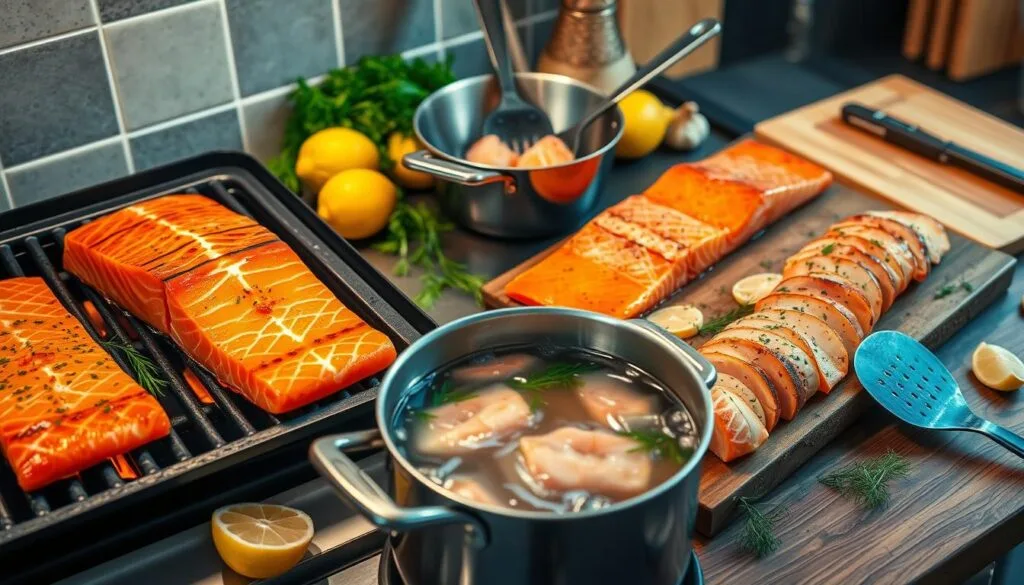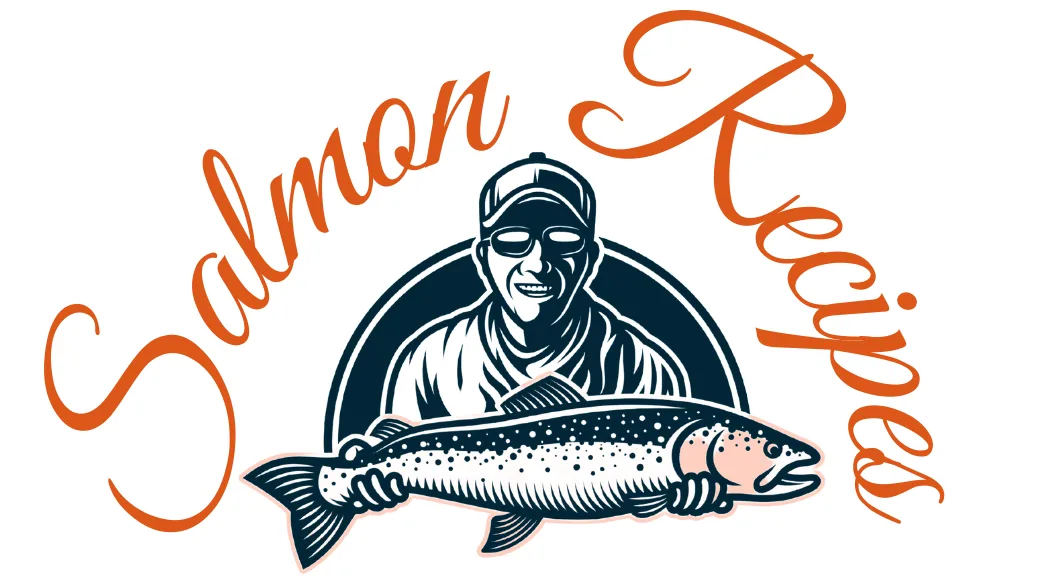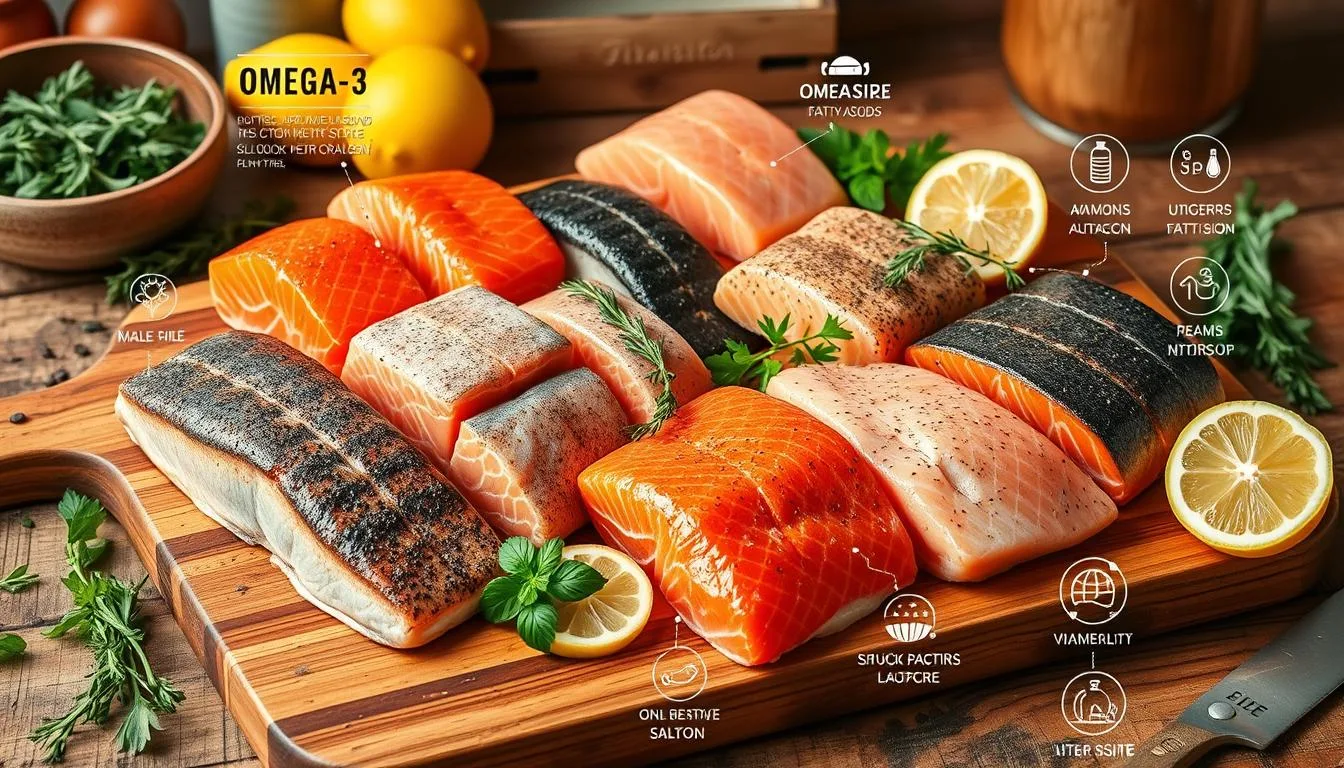Can Salmon is a nutritional powerhouse that can be eaten with great health benefits. It’s full of essential nutrients, including protein and omega-3 fatty acids. These support overall wellness.
The popularity of salmon has grown a lot in recent years. Canned Alaskan salmon sales went up by over 30% in 2020. This shows more people know about its nutritional value.
When you think about adding salmon to your diet, you’ll find many types. Each has its own taste and nutritional benefits. Whether it’s wild-caught Alaskan pink salmon or premium sockeye, they all offer something special.
Knowing what’s in salmon helps you make better food choices. Wild-caught salmon stands out for its nutrients and heart health benefits. The American Heart Association agrees.
Table of Contents
Understanding Salmon: Types and Varieties
Exploring wild caught salmon opens up a world of different species and tastes. The Pacific Ocean is home to many salmon varieties. Each one has its own special traits and flavors.
The salmon family has many types, each offering something unique. Wild caught salmon from Alaska is among the best in the market.
Different Species of Pacific Salmon
Pacific salmon has six amazing species. Five of these are commonly caught in U.S. and Canadian waters:
- King (Chinook) Salmon: Known for highest fat content
- Sockeye Salmon: Bright red-orange flesh
- Coho (Silver) Salmon: Milder flavor
- Pink Salmon: Most common variety
- Chum Salmon: Lower fat content
Atlantic vs Pacific Salmon Differences
Your choice of salmon greatly depends on its origin. Alaskan salmon is wild caught, while Atlantic salmon is farm-raised.
| Characteristic | Pacific Salmon | Atlantic Salmon |
|---|---|---|
| Availability | Seasonal | Year-round |
| Farming Status | Mostly Wild | Entirely Farm-Raised |
| Fat Content | Varies by Species | Consistent |
Color Variations in Salmon Species
Salmon colors range from pale pink to vibrant red-orange. These colors show the unique traits of each species. Wild caught salmon from different places have their own color variations.
“The beauty of salmon lies not just in its taste, but in its diversity of flavors and appearances.” – Seafood Experts
Nutritional Profile of Salmon
Salmon is a nutritional powerhouse. It’s packed with essential nutrients that support your health. Every serving of this Omega-3 rich salmon offers vitamins, minerals, and high-quality protein.
A standard 3-ounce portion of salmon provides remarkable nutritional benefits:
- 20.1 grams of protein (40% Daily Value)
- Vitamin D: 17.8 mcg (89% Daily Value)
- Vitamin B12: 4.7 mcg (195% Daily Value)
- Selenium: 29.2 mcg (53% Daily Value)
Omega-3 rich salmon isn’t just delicious—it’s a nutritional goldmine that supports heart, brain, and overall wellness.
The fat composition of salmon is noteworthy. It has 1.249g of Omega-3 fatty acids per serving. This is 78% of its total fat content. Salmon’s Omega-3 to Omega-6 ratio is balanced at 10.96, making it a great choice for nutritional optimization.
Beyond macronutrients, salmon delivers critical micronutrients. It contains essential amino acids like Lysine (1750mg, 83% RDI) and Leucine (1557mg, 57% RDI). These support muscle health and metabolic functions.
When you choose salmon, you’re selecting a nutrient-dense food. It offers comprehensive nutritional support with minimal caloric impact.
Wild-Caught vs Farm-Raised Salmon Debate
When it comes to salmon, you might wonder about the differences between wild-caught and farm-raised varieties. Understanding these differences can help you make better choices about your seafood. It also supports sustainable fishing practices.
Environmental Impact of Salmon Production
The environmental impact of salmon production is complex. Wild-caught salmon fishing can affect marine ecosystems. Fish farms, on the other hand, raise concerns about habitat disruption and contamination.
- Half of global salmon comes from fish farms
- By 2030, fish farms will provide nearly two-thirds of global seafood consumption
- Sustainable fishing practices are crucial for ecosystem preservation
Nutritional Comparison
Nutritional profiles differ between wild and farmed salmon. Each offers unique benefits to consumers.
| Nutrient | Wild-Caught Salmon | Farmed Salmon |
|---|---|---|
| Protein | 22g per 113g | 23g per 113g |
| Fat Content | 5g (8% DV) | 15g (19% DV) |
| Omega-3 Fatty Acids | Lower levels | Higher levels |
Safety and Contamination Concerns
Both wild and farmed salmon are generally safe to eat. The FDA says salmon is a low-mercury seafood option. Sustainable fishing practices have helped lower contaminant levels in recent years.
The American Heart Association recommends two servings of fatty fish like salmon per week for optimal health benefits.
Early studies raised concerns about contaminants in farmed salmon. But recent research shows both wild and farmed options are safe in moderation. The key is to choose salmon from reputable sources that focus on sustainable fishing practices.
Health Benefits of Consuming Salmon
Salmon is a nutritional powerhouse that can greatly improve your health. It offers more than just nutrients. It supports your body’s overall function.
Adding salmon to your diet gives you a great source of nutrients. These nutrients are key for your health. Here are some amazing benefits of eating salmon:
- Heart Health Support: Omega-3 fatty acids in salmon help reduce inflammation and lower cardiovascular risk
- Brain Function Enhancement: Rich nutrients support cognitive performance and mental clarity
- Joint Protection: Anti-inflammatory properties help maintain joint health and mobility
- Muscle Development: High-quality protein supports muscle growth and repair
Salmon’s nutritional profile is impressive. A single serving gives you essential nutrients for your daily health.
| Nutrient | Wild Salmon | Farmed Salmon |
|---|---|---|
| Calories | 182 | 206 |
| Protein | 25g | 22g |
| Omega-3 Fatty Acids | 2.2g | 2.3g |
| Vitamin B12 | 127% DV | 117% DV |
“Salmon is not just food, it’s a nutrient-dense solution for comprehensive health maintenance.”
Eating two servings of salmon a week can boost your nutrition. Salmon supports heart health, brain function, and muscle strength. It’s a great addition to your diet.
Can Salmon Be Eaten Raw?
Raw salmon is an interesting choice for foodies, but it’s important to know the risks. Sushi fans might want to try it, but it’s key to understand the safety first.
Eating raw salmon needs careful steps. Not all salmon is safe to eat without the right preparation.
Safety Precautions for Raw Consumption
To enjoy raw salmon safely, follow these guidelines:
- Freeze salmon at -4°F for at least seven days
- Ensure fish comes from reputable sources
- Check for professional processing standards
Risks of Consuming Raw Salmon
Raw salmon can pose health risks. Here are some:
| Risk Category | Potential Consequences |
|---|---|
| Parasitic Infections | 1 in 4 wild-caught salmon may carry parasites |
| Bacterial Contamination | Potential Listeria monocytogenes exposure |
| Vulnerable Populations | Higher risk for pregnant women and immunocompromised individuals |
“Proper preparation is key to safely enjoying salmon in its raw form.”
The FDA says to cook salmon to 145°F to kill germs. Farm-raised salmon has lower parasite risks than wild-caught.
If unsure about raw salmon, cooking is safer. Always choose the healthiest way to eat seafood.
Essential Omega-3 Fatty Acids in Salmon

Omega-3 fatty acids are found in abundance in Omega-3 rich salmon. They are key for your health, helping your brain and heart. Eating salmon gives your body EPA and DHA, two important omega-3s.
Looking at the nutritional value of Omega-3 rich salmon shows its fatty acid profile:
- Atlantic salmon contains about 2,440 mg of omega-3s per six-ounce filet
- Farmed salmon has up to 4,504 mg of omega-3 fatty acids
- Wild salmon offers around 1,774 mg of essential fatty acids
Nutrition experts say you should eat 250-500 milligrams of EPA and DHA daily. Eating two servings of fatty fish like salmon a week can help you meet this. The body absorbs these dietary lipids at an impressive rate of about 95%.
“Salmon is nature’s nutritional multivitamin, packed with omega-3 fatty acids that support your body’s most critical functions.” – Nutrition Research Institute
Your body can’t make these fatty acids on its own. So, getting them from food is important. Salmon is a great source of omega-3s, but the body only converts ALA to EPA and DHA less than 15% of the time.
Selecting and Purchasing Fresh Salmon
Buying fresh salmon online needs careful thought to get the best seafood. The digital world makes it easy to buy fresh salmon. But, knowing what to look for is key for a great meal.
When you shop for fresh salmon online, several important factors help you choose well:
Quality Indicators for Fresh Salmon
- Look for vibrant, consistent color without discoloration
- Seek out sellers with rapid shipping and cold-chain packaging
- Check for detailed product descriptions and origin information
- Verify the harvest or processing date
Fresh salmon online should show certain signs of high quality. The salmon’s look tells us about its freshness and care.
Smart Storage and Handling Tips
- Refrigerate immediately upon delivery at 32°F to 38°F
- Consume within 1-2 days of receiving
- Keep salmon in its original vacuum-sealed packaging
- Place on the lowest shelf of your refrigerator
“Quality salmon starts with smart selection and proper storage” – Seafood Experts
Understanding price differences is important when buying fresh salmon online. Prices vary from $8 to $100 per pound. This depends on the type and source of salmon. Wild-caught salmon like King or Sockeye is pricier because of its better taste and health benefits.
Choosing fresh salmon online lets you enjoy top-quality seafood at home. By following these tips, you’ll have a tasty and healthy meal every time.
Sustainable Fishing Practices and Salmon
Our oceans need careful management to stay healthy. Alaskan salmon fisheries lead the way in this effort. They show us how to protect marine resources while fishing.
Choosing the right salmon is key. Not all salmon is caught the same way. Your choice can help or hurt marine conservation.
- Alaska ranks among the world’s most well-managed fisheries
- Over 200 million wild salmon are harvested annually in the North Pacific Ocean
- Marine Stewardship Council (MSC) Certification ensures environmental standards are met
Sustainable salmon fishing means keeping fish populations healthy. It also helps the ocean and local fishing communities. Responsible harvesting protects both marine ecosystems and local fishing communities.
“Sustainability is not just about current consumption, but preserving resources for future generations.” – Marine Conservation Expert
Here are some sustainable salmon choices:
| Salmon Type | Recommended Source | Sustainability Rating |
|---|---|---|
| Chinook Salmon | U.S. or Canada | High |
| Sockeye Salmon | Wild-caught from U.S. | High |
| Pink Salmon | Wild-caught from Washington | High |
By picking responsibly sourced Alaskan salmon, you help the ocean. You also make sure salmon can keep thriving for the future.
Preparation Methods and Cooking Techniques
Exploring how to cook salmon opens up a world of tasty recipes. Salmon is a versatile fish that works well with many cooking methods. This makes it a favorite among home cooks and food lovers.

There are several popular ways to prepare salmon for delicious results:
- Grilling: Creates a beautiful char and smoky flavor
- Baking: Provides even, gentle cooking
- Poaching: Delivers a delicate, tender texture
- Pan-searing: Develops a crispy exterior
Essential Cooking Guidelines
The FDA says to cook salmon to 145°F (63°C) for food safety. This simple rule helps you cook salmon perfectly every time.
“The key to great salmon is not overcooking – keep it moist and tender!” – Professional Chef
Nutritional Cooking Insights
Your cooking method can affect salmon’s nutritional value. Each method keeps nutrients in different ways. Poaching and steaming keep more of the fish’s omega-3 fatty acids.
| Cooking Method | Preparation Time | Calories per Serving |
|---|---|---|
| Grilling | 10 minutes | 287 kcal |
| Baking | 15 minutes | 267 kcal |
| Pan-Searing | 8 minutes | 295 kcal |
Pro tip: Try different cooking methods to find your favorite. The best way to cook salmon is the method that makes you happy and matches your cooking skills.
Potential Risks and Considerations
Enjoying can salmon comes with understanding potential risks. It’s key for making smart food choices. Salmon is good for you, but some things need careful thought.
- Potential contaminant exposure
- Mercury content variations
- Seafood allergy concerns
- Sodium levels in processed salmon
“Understanding salmon’s nutritional profile helps make safer consumption decisions.”
Different people face different risks with can salmon. Some groups need to be extra careful:
- Pregnant women
- Young children
- Individuals with seafood allergies
- People managing cardiovascular conditions
| Risk Factor | Potential Impact | Recommended Action |
|---|---|---|
| Mercury | Neurological effects | Choose low-mercury salmon varieties |
| PCBs | Cancer risk | Select wild-caught salmon |
| Sodium | Hypertension | Limit processed salmon intake |
Your health is most important. Consulting healthcare professionals can help. They can guide you on safely adding can salmon to your meals.
Recommended Serving Sizes and Frequency
Knowing how much salmon to eat is key to getting its health benefits without risks. The right amount varies by age and health conditions.
Serving Size Guidelines for Different Age Groups
Salmon intake varies with age and nutritional needs. Here’s a detailed guide:
- Children Ages 1-3: 1 ounce per serving
- Children Ages 4-7: 2 ounces per serving
- Children Ages 8-10: 3 ounces per serving
- Children Age 11+: 4 ounces per serving
- Adults: 8 ounces of seafood recommended weekly
Special Considerations for Pregnant Women
Pregnant women need special care with salmon. The FDA has specific guidelines for safety:
- Consume 8-12 ounces of low-mercury seafood weekly
- Limit serving size to 4 ounces
- Choose “Best Choices” like salmon
- Aim for 2-3 servings per week
“Eating salmon twice weekly provides essential omega-3 fatty acids crucial for overall health.” – Nutritional Expert
Additional Consumption Recommendations
| Category | Recommended Servings | Serving Size |
|---|---|---|
| Adults | 2 servings per week | 4-6 ounces |
| Pregnant Women | 2-3 servings per week | 4 ounces |
| Children | 2 servings per week | 1-4 ounces depending on age |
Note: Always consult with a healthcare professional for personalized nutritional advice tailored to your specific health needs.
Conclusion
Understanding can salmon is all about balance in nutrition and health. Salmon is packed with nutrients and omega-3 fatty acids. These are great for your overall health. You can choose from fresh, canned, or wild-caught salmon, making it a flexible protein source.
Your food choices are important. Salmon is good for you, but how you prepare it and where it comes from matters. Canned salmon is a budget-friendly option that’s easy to store and access.
It’s important to eat salmon responsibly. Choose salmon from sustainable sources and learn how to cook it right. This way, you get the most health benefits without risks. Always check serving sizes and cooking methods to enjoy salmon’s nutritional perks.
In the end, salmon is a great choice for a healthy diet. It’s full of omega-3s and easy to use in many recipes. Salmon is a tasty and nutritious option for anyone looking to eat better.
FAQ
Is salmon safe to eat?
Yes, salmon is safe to eat and is good for you. Make sure it comes from trusted sources. Also, cook it well to avoid health risks.
What are the main health benefits of eating salmon?
Salmon is packed with protein and omega-3 fatty acids. It’s great for your heart and brain. It also has vitamins D and B12, and selenium, which are good for you.
What’s the difference between wild-caught and farm-raised salmon?
Wild-caught salmon tastes better and has more omega-3s. Farm-raised salmon is cheaper and easier to find. Wild salmon comes from nature, while farm-raised is raised in controlled places.
Can I eat salmon raw?
Raw salmon is okay if it’s been flash-frozen. This kills parasites. Buy it from trusted places to avoid foodborne illnesses.
How often should I eat salmon?
Eat salmon 2-3 times a week for the best omega-3 benefits. This helps avoid too much of bad stuff. Talk to a doctor about how much is right for you.
What’s the best way to cook salmon?
Cook salmon at 145°F (63°C) for safety and flavor. You can bake, grill, pan-sear, or poach it. Don’t overcook to keep it moist and nutritious.
Is salmon sustainable?
Many salmon fisheries, like those in Alaska, are sustainable. Look for MSC certification to buy eco-friendly salmon. Alaskan salmon is a top choice for sustainable seafood.
What should I look for when buying salmon?
Choose fresh salmon with bright color, firm texture, and a clean smell. For frozen, check for proper seal and no freezer burn. Opt for wild-caught and sustainable options.

